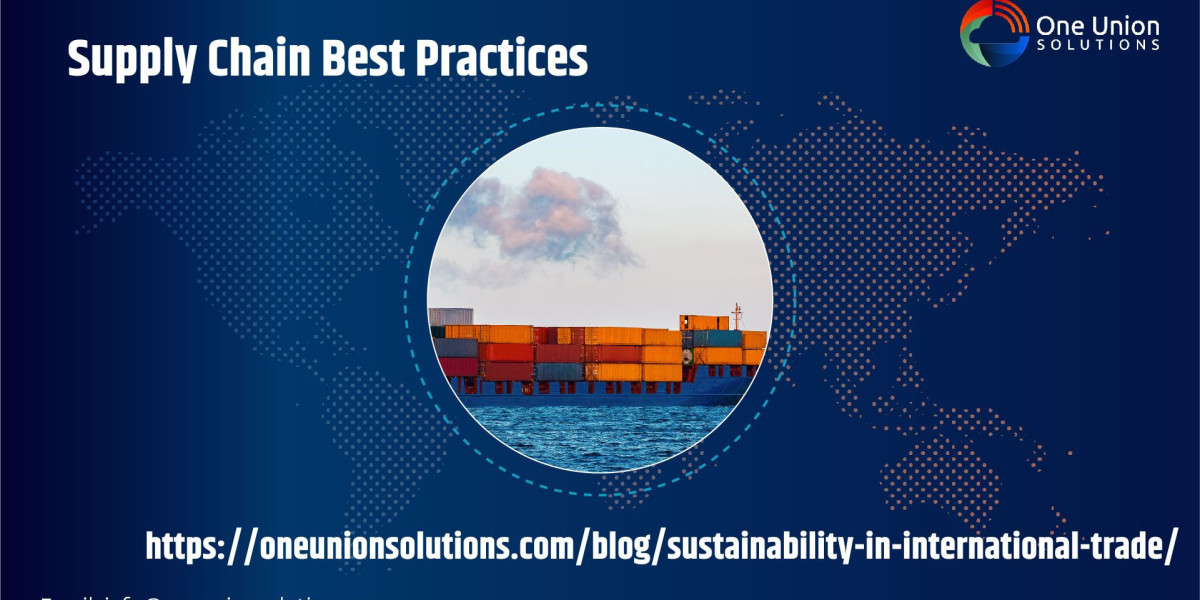In today’s competitive global marketplace, supply chains are no longer judged only by efficiency or cost-effectiveness. Modern companies are expected to build sustainable, transparent, and resilient supply chains that support long-term growth. The concepts highlighted in One Union Solutions’ discussion on sustainability in international trade reflect the growing shift toward environment-friendly and technology-driven logistics.
Below are the most important supply chain best practices businesses should adopt to stay competitive and future-ready.
1. Embrace Technology and Digital Transformation
Technology is now the backbone of a modern supply chain. To stay competitive, companies must adopt systems that offer transparency, speed, and accuracy.
AI & Machine Learning
AI-powered forecasting helps companies predict demand patterns, optimize stock levels, and reduce wastage. Predictive analytics also support route planning, cost control, and delivery performance.
Internet of Things (IoT)
IoT-enabled smart containers and tracking devices allow real-time visibility of shipments. They monitor temperature, humidity, and location—helping reduce delays, prevent damage, and maintain product quality.
Blockchain for Transparency
Blockchain records every supply chain step in an immutable ledger. This brings complete transparency from sourcing to delivery, reduces fraud, and improves trust among customers, suppliers, and logistics partners.
2. Adopt Green Logistics and Reduce Carbon Footprint
Sustainability is a priority for global trade. Customers, governments, and regulators demand environment-friendly operations.
Route Optimization
Using digital tools to plan shorter, fuel-efficient routes reduces emissions and improves delivery speed. Optimized routes save time, fuel, and operational cost.
Efficient Transportation Models
Models such as DDP (Delivered Duty Paid) allow companies to consolidate shipments and streamline customs processes—reducing unnecessary fuel use and lowering carbon emissions.
Circular Logistics
Circular logistics focuses on recycling, reusing materials, and minimizing waste. This approach not only protects the environment but also reduces supply chain cost in the long run.
3. Strengthen Compliance and Documentation Accuracy
A strong supply chain runs on smooth customs clearance, accurate paperwork, and adherence to international regulations.
Follow Global Compliance Frameworks
Businesses should comply with:
Incoterms
HS Code classification
AEO (Authorized Economic Operator) guidelines
Country-specific customs rules
Compliance helps avoid delays, penalties, or seizure of goods.
IOR/EOR Services
Importer of Record (IOR) and Exporter of Record (EOR) frameworks simplify trade, especially for companies entering new markets. They ensure all duties, taxes, and documents are handled correctly—reducing compliance risk.
4. Leverage Data Analytics for Better Decision-Making
Data-driven systems allow companies to predict problems before they occur.
Real-Time Supply Chain Visibility
Tracking tools provide live updates on shipment status, delays, or risks. This allows companies to take quick action and prevent supply chain failures.
Predictive Analytics
Predictive models analyze historical data to forecast:
demand fluctuations
inventory requirements
lead times
transportation bottlenecks
This helps avoid stockouts, excess inventory, and waste.
Risk Management
Analytics support proactive risk management by identifying vulnerabilities such as supplier disruptions, port delays, or documentation issues.
5. Focus on Governance, Ethics, and Social Responsibility
A sustainable supply chain is not just about the environment—it’s also about people and fair practices.
Ethical Sourcing
Companies should ensure that suppliers follow labor laws, fair wages, and safe working conditions. Ethical standards increase brand trust and reduce social risks.
Worker-Driven Social Responsibility
Empowering workers in the supply chain creates a healthier, more transparent system. It also ensures suppliers maintain quality and comply with global labor norms.
International Collaboration
Following international guidelines improves supply chain accountability and ensures long-term sustainability.
6. Build a Circular Economy Mindset
Circular economy practices reduce dependency on raw materials and lower waste.
Circular Procurement
Businesses should source materials that can be reused, recycled, or repurposed. This reduces environmental impact and material cost.
Reverse Logistics
Efficient management of returned goods, used materials, and packaging waste ensures sustainability. Reverse logistics also boosts customer satisfaction and supports green initiatives.
Recycling and Reuse
A closed-loop supply chain lowers carbon emissions and improves resource efficiency.
7. Strengthen Supplier Relationships and Collaboration
A strong supply chain depends on reliable partners.
Supplier Engagement
Regular communication with suppliers leads to better quality, transparent timelines, and smoother coordination.
Training and Capacity Building
Companies should train their logistics partners and suppliers on:
sustainability practices
digital tools (IoT, AI, ERP)
documentation requirements
Performance Monitoring
Tracking KPIs such as on-time delivery, carbon footprint, quality compliance, and waste reduction helps maintain a high-performing supply chain.
Conclusion
Supply chain best practices are essential for building a resilient and sustainable global trade ecosystem. By adopting digital tools, strengthening compliance, reducing environmental impact, and working closely with suppliers, companies can ensure long-term growth and sustainability.
A future-ready supply chain is:
transparent
eco-friendly
technology-driven
compliant
resilient
Businesses that implement these practices position themselves as leaders in global trade and meet the rising expectations of customers, governments, and global markets.








